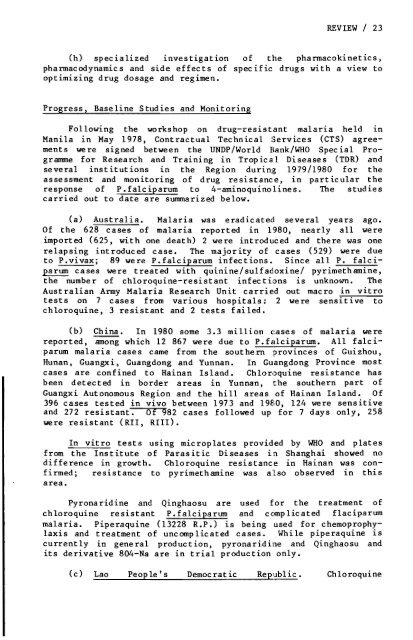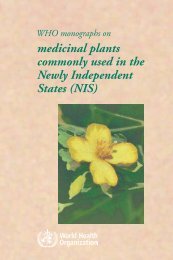Drug-Resistant Malaria - libdoc.who.int - World Health Organization
Drug-Resistant Malaria - libdoc.who.int - World Health Organization
Drug-Resistant Malaria - libdoc.who.int - World Health Organization
You also want an ePaper? Increase the reach of your titles
YUMPU automatically turns print PDFs into web optimized ePapers that Google loves.
REVIEW / 23<br />
(h) specialized investigation of the pharmacokinetics,<br />
pharmacodynamics and side effects of specific drugs with a view to<br />
optimizing drug dosage and regimen.<br />
Progress, Baseline Studies and Monitoring<br />
Following the workshop on drug-resistant malaria held 1n<br />
Manila in May 1978, Contractual Technical Services (CTS) agreements<br />
were signed between the UNDP/<strong>World</strong> Hank/WHO Special Progrannne<br />
for Research and Training in Tropic.!!.l Diseases (TDR) and<br />
several institutions in the Region during 1979/1980 for the<br />
assessment and monitoring of drug resistance, in particular the<br />
response of P.falciparum to 4-aminoquinolines. The studies<br />
carried out to date are summarized below.<br />
(a) Australia. <strong>Malaria</strong> was eradicated several years ago.<br />
Of the 628 cases of malaria reported in 1980, nearly all were<br />
imported (625, with one death) 2 were <strong>int</strong>roduced and there was one<br />
relapsing <strong>int</strong>roduced case. The majority of cases (529) were due<br />
to P.vivax; 89 were P.falciparum infections. Since all P. falciparum<br />
cases were treated with quinine/sulfadoxine/ pyrimethamine,<br />
the number of chloroquine-resistant infections is unknown. The<br />
Australian Army <strong>Malaria</strong> Research Unit carried out macro in vitro<br />
tests on 7 cases from various hospitals: 2 were sensitive to<br />
chloroquine, 3 resistant and 2 tests failed.<br />
(b) China. In 1980 some 3.3 million eases of malaria were<br />
reported, among which 12 867 were due to P.falciparum. All falciparum<br />
malaria cases came from the southern provinces of Guizhou,<br />
Hunan, Guangxi, Guangdong and Yunnan. In Guangdong Province most<br />
cases are confined to Hainan Island. Chloroquine resistance has<br />
been detected in border areas in Yunnan, the southern part of<br />
Guangxi Autonomous Region and the hill areas of Hainan Island. Of<br />
396 cases tested in vivo between 1973 and 1980, 124 were sensitive<br />
and 272 resistant. Of 982 cases followed up for 7 days only, 258<br />
were resistant (RII, RIll).<br />
In vitro tests using microplates provided by WHO and plates<br />
from the Institute of Parasitic Diseases in Shanghai showed no<br />
difference in growth. Chloroquine resistance in Hainan was confirmed;<br />
resistance to pyrimethamine was also observed in this<br />
area.<br />
Pyronaridine and Qinghaosu are used for the treatment of<br />
chloroquine resistant P.falciparum and c(~plicated flaciparum<br />
malaria. Piperaquine (13228 R.P.) is being used for chemoprophylaxis<br />
and treatment of uncomplicated cases. While piperaquine is<br />
currently in general production, pyronaridille and Qinghaosu and<br />
its derivative 804-Na are in trial production only.<br />
(c) ~L=a=o~ __ =P~e~o~p~l~e~'s~ ___ D~em==o~c=r=a=t~i~c~ __ ~R=e~p~1j.blic.<br />
Chloroquine
















